 W
WThe Alto Paraná Atlantic forests, also known as the Paraná-Paraíba interior forests, is an ecoregion of the tropical moist forests biome, and the South American Atlantic Forest biome. It is located in southern Brazil, northeastern Argentina, and eastern Paraguay.
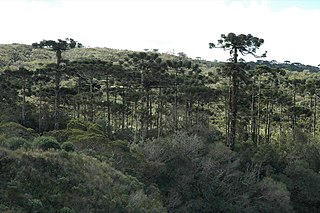 W
WThe Araucaria moist forests, officially classified as mixed ombrophilous forest in Brazil, are a coniferous forest ecoregion of the Atlantic Forest Biome. The forest ecosystem is located in southern Brazil and northeastern Argentina. The ecorregion also includes select areas of open field called "campos de cima da serra" or "coxilhas".
 W
WThe Atlantic Coast restingas is an ecoregion of the tropical and subtropical moist broadleaf forests biome, and the South American Atlantic Forest biome. It is located along Brazil's Atlantic coast, from the country's northeast to its southeast.
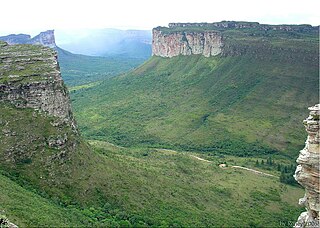 W
WThe Atlantic dry forests are a tropical dry forest ecoregion of the Atlantic Forest Biome, located in eastern Brazil.
 W
WThe Atlantic Forest is a South American forest that extends along the Atlantic coast of Brazil from Rio Grande do Norte state in the north to Rio Grande do Sul state in the south, and inland as far as Paraguay and the Misiones Province of Argentina, where the region is known as Selva Misionera.
 W
WThe Bahia coastal forests are a tropical moist broadleaf forest ecoregion of eastern Brazil, part of the larger Atlantic Forest region.
 W
WThe Bahia interior forests is an ecoregion of eastern Brazil. It is part of the larger Atlantic forests biome complex, and lies between the Bahia coastal forests and the dry shrublands and savannas of Brazil's interior.
 W
WThe Bahia Mangroves is a tropical ecoregion of the mangroves biome, and the South American Atlantic Forest biome, located in Northeastern Brazil.
 W
WThe Caatinga enclaves moist forests is an ecoregion of the Tropical moist forests Biome, and the South American Atlantic Forest biome. It is located in northeastern Brazil.
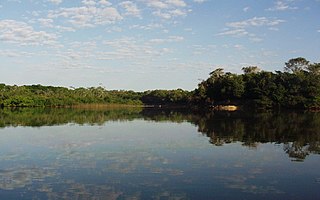 W
WCantão is a tropical forest ecosystem located in the central Araguaia river basin, the southeastern edge of the Amazon biome, in the Brazilian state of Tocantins. It is one of the biologically richest areas of the eastern Amazon, with over 700 species of birds, nearly 300 species of fish, and large populations of endangered species such as the giant otter and the black cayman. About 90% of the Cantão ecosystem is protected within Cantão State Park.
 W
WCerradão is a type of dry forest found in Brazil, associated with the cerrado savanna ecoregion.
 W
WThe Chiquitano dry forests is a tropical dry broadleaf forest ecoregion in Bolivia and Brazil. The ecoregion is named for the Chiquitano people who live in the region.
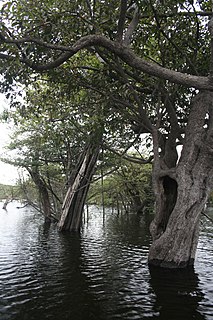 W
WIgapó is a word used in Brazil for blackwater-flooded forests in the Amazon biome. These forests and similar swamp forests are seasonally inundated with freshwater. They typically occur along the lower reaches of rivers and around freshwater lakes. Freshwater swamp forests are found in a range of climate zones, from boreal through temperate and subtropical to tropical. In the Amazon Basin of Brazil, a seasonally whitewater-flooded forest is known as a várzea, which is similar to igapó in many regards; the key difference between the two habitats is in the type of water that floods the forest.
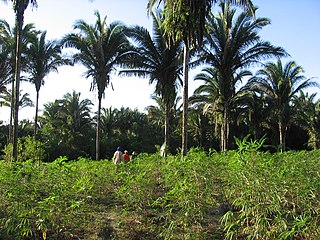 W
WThe Maranhão Babaçu forests is a tropical moist broadleaf forest ecoregion of north-central Brazil.
 W
WThe Northeastern Brazil restingas are an ecoregion of northeastern Brazil. Restingas are coastal forests which form on sandy, acidic, and nutrient-poor soils, and are characterized by medium-sized trees and shrubs adapted to the dry and nutrient-poor conditions found there.
 W
WThe Pernambuco coastal forests is an ecoregion of the Tropical moist broadleaf forests Biome, and the South American Atlantic Forest biome. It is located in northeastern Brazil.
 W
WThe "Pernambuco" interior forests is an ecoregion of the Tropical and subtropical moist broadleaf forests Biome, and the South American Atlantic Forest biome. It lies in eastern Brazil between the coastal Pernambuco coastal forests and the dry Caatinga shrublands of Brazil's interior.
 W
WRestinga — a spit and a distinct type of coastal Tropical and subtropical moist broadleaf forest, found in eastern Brazil.
 W
WThe Private Reserve of Natural Heritage (RPPN) of University of Santa Cruz do Sul (Unisc) is a protected area created in 2009, through Ordinance nº 16, of March 18, having an area of 221,39 hectares, being nowadays one of the largest protected area of this category (RPPN) in Rio Grande do Sul state, Brazil. This preservation area is within the Atlantic Forest Biome and the predominant vegetation is the seasonal deciduous forest.
 W
WThe Serra do Mar coastal forests is an ecoregion of the tropical moist forests biome, and of the South American Atlantic Forest biome.
 W
WThe Tijuca Forest is a tropical rainforest in the city of Rio de Janeiro, Brazil. It is claimed to be the world's largest urban forest, covering some 32 km² (12.4 mi²), although there are sources assigning this title to the urban forest of Johannesburg, South Africa, where between 6 and 9.5 million trees were planted.